

The Thrill of Night Safaris and Nocturnal Wildlife in Africa
Introduction.
Being on an early-morning or afternoon game drive in the wilds of Africa , with the promise of getting close to animals in their natural habitat is a truly unique experience. But the thrills don’t have to stop at sundown – night safaris provide an exhilarating experience, offering a unique lens to view the continent’s rich wildlife.

Unlike traditional daytime safaris, night drives allow visitors to witness the mysterious behaviours of creatures that only emerge after dusk. Your guides will shed light on the nocturnal animals that call this land home and the distinctive experiences that night safaris offer.
Key Takeaways: Night Safaris and Nocturnal Wildlife
Evolution of night safaris in africa.
After a slow start, night drives evolved to incorporate more sophisticated equipment and vehicles. The introduction of spotlighting, where powerful lights are used to spot animals in the dark, revolutionized night safaris. This practice has been refined to ensure minimal disturbance to wildlife by using red lights.
Red Spotlighting on Night Drives
Mammals, except for primates like us, often can’t see colors well and red light doesn’t affect their night vision much. Scientists are still studying if they can see red light at all. Mammals’ eyes have more rods, which detect light, than cones, which see colours. This is why many African mammals have great night vision.
The pupil in the eye controls how much light comes in. It adjusts slowly over the day, but bright artificial lights, like spotlights, can blind them suddenly because they have more rods.
When you see videos of night-time predators caught in bright white lights, they might sit or lie down. This isn’t a good sign; they are temporarily blinded and stay still until they can see again, which can take up to an hour.
Today, night safaris in Africa are a blend of adventure, education, and conservation. They are conducted with a deep respect for the natural habitat and the well-being of the nocturnal species.
Nocturnal Wildlife: An Overview
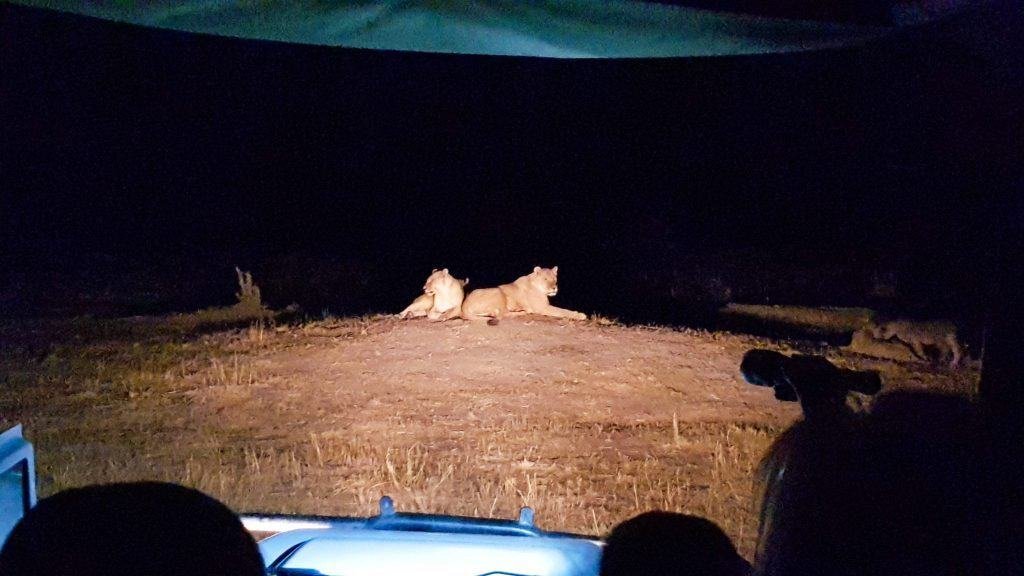
Unique Adaptations
Nocturnal animals in Africa have evolved unique adaptations to thrive in the dark. These adaptations include enhanced senses such as better hearing, sight, and smell.
Common Species
Commonly encountered nocturnal species on African night safaris include the elusive leopard (if you are lucky), the cunning hyena, and various species of owls and nocturnal birds. Smaller, less-seen creatures like the bushbaby and impala can also be spotted and if you see an aardvark then please let me know – you probably don’t realise quite how lucky you have been!
Ecological Roles
These nocturnal creatures play crucial roles in the ecosystem, from controlling pest populations to seed dispersal. Understanding their behaviours and roles offers insight into the complex web of the African wilderness.
Types of Night Safaris
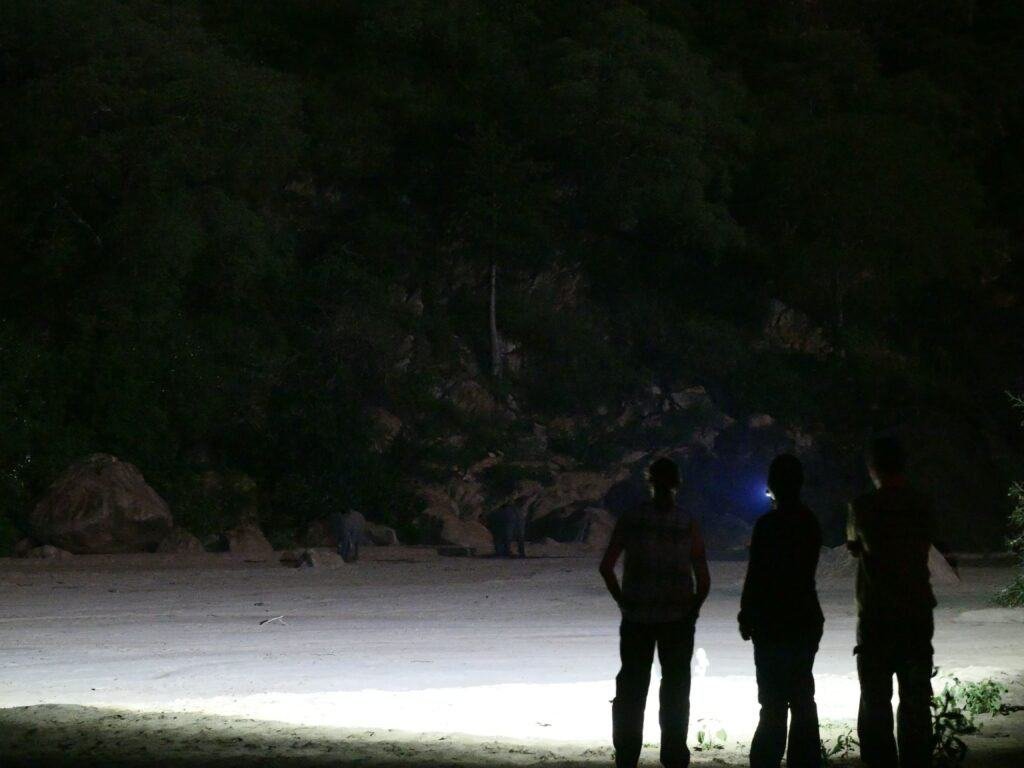
Guided Tours
Guided tours are the most common form of night safaris in Africa, offering expert knowledge and enhanced safety. These tours use vehicles equipped with spotlights and are often led by experienced guides.
Self-Drive Safaris
Some reserves allow self-drive night safaris, offering a more personal and adventurous experience. These are typically recommended for more experienced safari-goers familiar with the terrain and wildlife behaviour.
The Sensory Experience of Night Drives in Africa
Engaging the senses.
Night safaris in Africa offer a sensory experience unlike any found during the day. The darkness heightens visitors’ senses, making every sound and movement more pronounced.
The African night resonates with unique sounds: the distant roar of a lion, the laugh of hyenas, and the rustling of small creatures in the underbrush. These sounds create a symphonic backdrop that is both thrilling and educational.
Vision takes on a new dimension under the cover of darkness. Spotlights and night-vision equipment reveal the glowing eyes of nocturnal animals, offering glimpses into their secretive world.
The night air carries distinct scents, from the earthy aroma of the savannah to the subtle scent trails left by animals. This sense often alerts safari-goers to the presence of wildlife before they are seen.
Emotional and Psychological Impact
The mystery of the unknown and the thrill of potential encounters evoke a mix of excitement and reverence for nature. This unique combination of sensory engagement makes night safaris a deeply memorable experience. A game drive after sunset gets your heart racing!
Animal Behaviors at Night in Africa
Predatory activities.
Many of Africa’s predators are more active at night. Leopards, lions, and hyenas use the cover of darkness for hunting, utilizing their keen senses to track prey.
Hunting Strategies
Each predator has a unique hunting strategy that is often more observable during night safaris. For example, lions may hunt in packs, while leopards rely on stealth and surprise.
Mating Rituals
Nighttime is also a critical period for mating rituals among various species. The darkness provides a cover for intimate behaviours, and night safaris may offer rare glimpses into these private moments.
Territory Marking and Defense
Territorial behaviours, such as marking and patrolling, are common nocturnal activities. These are crucial for understanding the social structures and hierarchies within the animal kingdom.
Adaptations for Survival
Nocturnal animals have developed various adaptations for survival in the dark, from acute hearing and night vision to specialized hunting techniques. Observing these adaptations provides insight into the evolutionary marvels of African wildlife.
Conservation Efforts for Nocturnal Wildlife in Africa
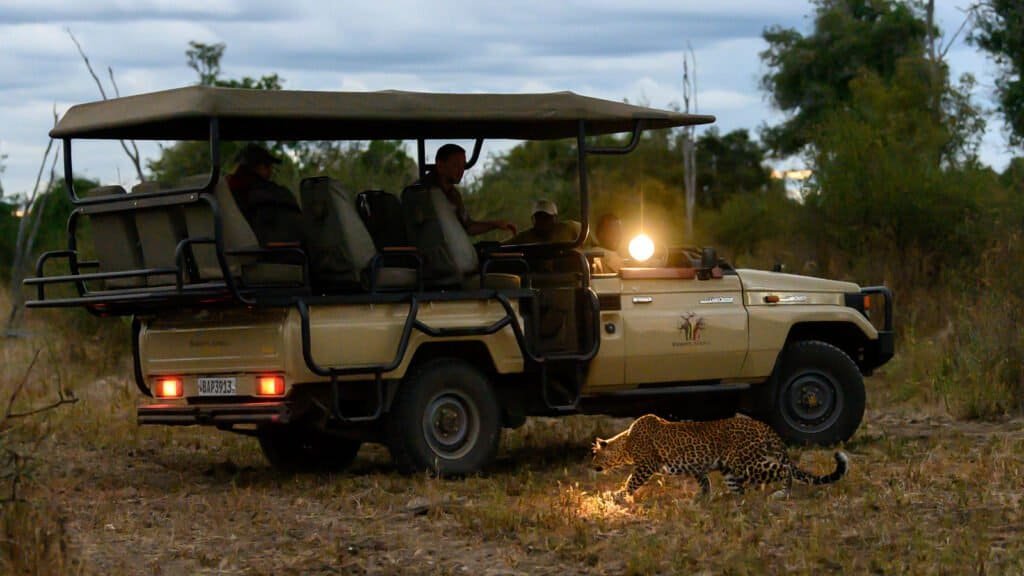
Challenges Faced by Nocturnal Species
Nocturnal species face unique challenges, including habitat loss, human-wildlife conflicts, and poaching. These threats are often exacerbated by their elusive nature, making them harder to monitor and protect.
Conservation Initiatives
Various conservation initiatives focus on protecting nocturnal wildlife. These include research on nocturnal species’ behaviour, habitat preservation efforts, and anti-poaching campaigns.
Community Involvement
Involving local communities in conservation efforts is crucial. Educational programs and community-based tourism initiatives help foster a sense of stewardship and provide economic incentives for conservation.
The Role of Night Safaris in Conservation
Responsible night safaris play a role in conservation by raising awareness and generating funds. By showcasing the beauty and importance of nocturnal wildlife, these safaris help in garnering support for conservation efforts.
Responsible Tourism Practices for Night Safaris in Africa
Minimizing disturbance.
Tourists are encouraged to respect the natural behaviour of wildlife. This includes keeping noise to a minimum and using spotlights responsibly to avoid disturbing animals.
Environmental Impact
Responsible safari practices also involve minimizing environmental impact. This includes following designated routes to prevent habitat damage and adhering to park regulations.
Waste Management
Proper disposal of waste and avoiding littering are critical for maintaining the pristine nature of safari environments.
Supporting Local Communities
Choosing safari operators who work with and support local communities can contribute to sustainable tourism. This includes employing local guides and supporting community-owned lodges.
Education and Awareness
Tourists should educate themselves about the wildlife and environments they will encounter. Understanding the ecological and cultural significance of the areas visited enhances the safari experience and promotes respect for the natural world.
Technologies and Equipment for Night Safaris in Africa
Night vision tools.
Advancements in night vision technology have greatly enhanced the night safari experience. Infrared and thermal imaging devices allow for the observation of wildlife without the need for visible light, thus minimizing disturbance to the animals.
Spotlighting
Spotlighting, when done responsibly, is a popular method for wildlife observation in Africa. These powerful lights can reveal hidden nocturnal creatures, but red light filters should be used where possible.
Photography Equipment
Nighttime photography on safaris has become increasingly popular. Equipment like high-ISO cameras and lenses suitable for low light conditions are essential for capturing the elusive moments of nocturnal wildlife.
While less common, drones equipped with night vision cameras can provide unique aerial perspectives of the nocturnal landscape. However, their use is strictly regulated in many reserves to prevent disturbance to wildlife and is generally part of anti-poaching or surveillance operations.
Communication Devices
For safety and coordination, especially in remote areas, reliable communication devices are crucial. This includes radios and GPS systems, ensuring that drivers can contact the lodge or other drivers if required.
Safety Measures and Guidelines for Night Safaris in Africa
Following guide instructions.
The most important safety measure on a night safari is adhering to the instructions of the guide. Their expertise and understanding of animal behaviour are crucial for a safe experience. Familiarise yourself with additional aspects of safari etiquette in this article .

Wildlife Interactions
Maintaining a safe distance from wildlife is imperative. Nighttime can make animals more unpredictable, and respecting their space is key for the safety of both the animals and the visitors.
Emergency Protocols
Being aware of emergency protocols and having a first-aid kit are essential. Guides are typically trained in handling emergencies, but visitors should also be prepared if driving their own vehicle.
Vehicle Safety
Ensuring that vehicles are well-maintained and equipped for nighttime conditions is vital. This includes having proper lighting and communication equipment.
Personal Safety
Visitors should wear appropriate (warm) clothing and be prepared for the varied conditions of the African night, from temperature changes to potential insect bites.
Best Destinations for Night Safaris in Africa
South africa.
South Africa offers a plethora of options for night safaris, with its diverse landscapes and rich wildlife. Parks like Kruger National Park and private reserves in the Sabi Sand offer unforgettable nocturnal experiences.
Kenya’s Masai Mara is renowned for its night safaris, providing opportunities to see the Big Five and other nocturnal creatures in their natural habitat in private conservancies .
Many of Tanzania’s national parks and conservation areas offer unique night safari experiences, with a chance to witness an abundance of nocturnal predators. The parks in remote southern Tanzania are a far better bet than their more famous northern counterparts.
Namibia’s desert landscapes provide a different night safari experience, with opportunities to see rare desert-adapted species under the stars.
Botswana’s Okavango Delta and Chobe National Park are known for their pristine wilderness and the possibility of a sunset boat cruise on the Chobe offers a different perspective on nocturnal life.
Planning Your Night Safari in Africa
Best times to visit.
The best time for night safaris in Africa varies by region and the type of wildlife you wish to see. Generally, the dry season offers better visibility and wildlife viewing opportunities.
What to Bring
Essential items include warm clothing for the cooler night temperatures, binoculars, cameras suitable for low light, and insect repellent.
Health Precautions
Visitors should take necessary health precautions, including vaccinations and malaria prophylaxis where required. It’s also important to have travel insurance that covers safari activities.
Cultural Sensitivity
Understanding and respecting the local culture and customs of the areas visited enhances the experience and supports sustainable tourism practices.
The Future of Night Safaris in Africa
Emerging trends.
The future of night safaris in Africa is shaped by emerging trends like eco-tourism and technological advancements. There is a growing emphasis on sustainable practices that ensure minimal impact on wildlife and their habitats.
Eco-friendly Innovations
Innovations like electric safari vehicles and low-impact lighting are becoming more prevalent, reducing noise and pollution and enhancing the natural experience of night safaris.
Enhanced Wildlife Research and Monitoring
Advances in technology are not only improving the safari experience but also aiding in wildlife research and monitoring. This contributes to more effective conservation strategies for nocturnal animals.
Community-based Tourism
The future also sees a rise in community-based tourism, where local communities play a central role in managing and benefiting from night safari operations. This approach promotes conservation and provides economic benefits to local populations.
The Role of Education and Awareness
Education and awareness about nocturnal wildlife and their ecosystems are expected to be a significant focus. This involves integrating educational elements into safari experiences, thereby fostering a deeper appreciation and understanding of the importance of conservation efforts.
A Unique Safari Experience
Night drives in Africa offer a unique and exhilarating way to experience the continent’s diverse wildlife. They provide an intimate glimpse into the lives of nocturnal animals and their behaviours, which would otherwise remain hidden in the daylight.
Importance of Conservation
These safaris also play a crucial role in conservation efforts by raising awareness and generating funds for wildlife protection. By choosing responsible safari operators and following best practices, visitors can contribute to the preservation of these magnificent creatures and their habitats.
Final Thoughts
As night safaris continue to evolve, they hold the promise of offering even more sustainable, educational, and unforgettable experiences. The future of these safaris lies in balancing the thrill of adventure with the responsibility of protecting Africa’s nocturnal wildlife for generations to come.
A Travel Designer, not a Travel Agent.
I will use my unmatched experience and connections to help you create an unforgettable adventure in Africa. I offer truly personal service – that means you will only deal with me. Every trip contributes to local economies, conservation and community initiatives.
Sample Itineraries
Destinations
The Grown-up Travel Company
Lauvåsbakken 18, 7540 Klæbu, Norway
Talk to me: +47 4591 9660
(c) The Grown-up Travel Company 2024
Privacy Statement
Terms and Conditions
Join Me in Zimbabwe in May 2025!
A unique adventure through Africa’s untamed beauty in May 2025. On this 9-night itinerary we will start with a stay in Victoria Falls and then explore two world-renowned areas of wonderful Zimbabwe: Hwange National Park and Lake Kariba .
Staying at two legendary camps, Bomani and Musango, we will get to experience the thrill of the wilderness in two very different ways.
“This small-group safari, limited to just six guests , is designed to ensure a truly immersive adventure for those with limited time but very high expectations.” – Andy Higgs
Get your comprehensive free guide to planning the trip of a lifetime
Subscribe for help and advice on planning an adventure you will never forget, starting with my free 40+ page guide to planning your African adventure. Unsubscribe with 1 click at any time.
I hate spam and promise to keep your details safe. Read my privacy policy her
- Jun 11, 2021
8 highlights from the Singapore Zoo, Night Safari and River Safari

The Singapore Zoo , Night Safari and River Safari need no introduction.
After all, they’re some of Singapore’s staple attractions for both tourists and locals alike. The Singapore Zoo has won countless awards (including TripAdvisor’s top 5 zoos in the world), and the Night Safari was the world’s first-ever nocturnal zoo.
You may have visited these places as a kid, and are looking to make good use of your SingapoRediscovers Vouchers to make a return trip and spend the day with family or friends.
Having visited all three attractions in the last few months, here’s what I thought were the most memorable experiences.
Singapore Zoo
Animal feedings
There’s a small cost of $5 to feed the animals, but it’s one of the best ways to get up close and personal with them. Do take note of the feeding timings so you can better plan your visit.

There are goat, white rhino, elephant, giant tortoise and giraffe feedings. I would highly recommend the giant tortoise feeding over at the Reptile Garden. Having such long life spans (averaging 80 to 120 years), these gentle ‘giants’ are some of the oldest residents at the zoo.

The feeding allows you really close contact - you can step into their enclosure, pet their necks and shells and even take selfies with the friendly creatures! Just be careful they don’t step on your feet, as a fully-grown tortoise can weigh up to 250kg.

Hand-feeding them the cherry tomatoes is great fun too. Like myself, the one I fed was a really messy eater.

I also tried out the giraffe feeding, though that was less interactive as you can’t actually pet them or step into their enclosure for safety reasons. We were given a cup of carrots to feed them, and they gulped down the food in one mouthful so you have to be really quick with pictures. I still enjoyed the experience, but the feeding was over really fast.
Hamadryas baboons
When I was young, the polar bear enclosure used to be my favourite. Now that the last polar bear Inuka is gone, my favourite animal exhibit has to be that of the Hamadryas baboons.

Located at the Great Rift Valley of Ethiopia, the enclosure is fairly large and houses countless Hamadryas baboons along with a waterfall.

It's fascinating to see their social habits and characteristics too. The adult males are identified by their silvery mantle-like manes, and are double the size of females. The females are characterised by very prominent swollen red bottoms.
We saw some males grooming the females and also piggybacking them. Each male also has a clan of females, and even chases them and bite their necks if they stray too far. We’re lucky human males don’t exhibit the same behavior.

Whilst the baboons were the highlight, they weren't the only animals that I enjoyed seeing. The Asian elephants were a hot favourite, and there’s a sizeable seating area so you can take a break from walking around and simply observe these magnificent creatures.

Also, the delightful chimpanzees, whose exhibit resembles a jungle gym and high elements course. If you're lucky, you’ll spot them while they are particularly active and climbing up and down the multi-tiered structure.

It was thrilling to be so close to one of the orangutans too. He was sleeping soundly right next to the glass enclosure! The zoo also had a Jungle Breakfast with Wildlife activity where you get to meet them and 'dine' with them, which is currently suspended because of Covid. Do look out for it when it re-opens!
Rainforest Kidzworld
Even though this zone was designed for kids, I’m pretty sure the whole family will have a blast! Just like the animal feedings, you can really see the farmyard animals up close here.

The falabellas are particularly adorable, as well as the sociable goats. We even saw people feeding them leaves, though I’m pretty sure that isn’t actually permitted (you can pay to feed them actual food as part of the animal feedings) .
Unfortunately, some activities have been suspended due to social distancing measures, such as the pony rides, the falabella grooming and rabbit petting.
Night Safari

This is the very obvious highlight of the night safari - and for good reason. The iconic tram ride is complimentary, and trams come very frequently so we didn’t have to wait too long in queue.
I was quite disappointed that live tram commentary has been replaced by a recorded one though! Although it was still informative, it’s nice to have an actual tram guide who can build rapport with visitors and offer a more personal experience or insightful anecdotes regarding the animals.
The ride is around 35 to 40 minutes, and we took one of the first trams of the night at 7pm. I’d recommend that timing as there is still some daylight and you can better spot the animals.

Admittedly, some are really hard to see in the dark, even with each habitat being illuminated. Highlights were the Nile hippo, Asian lion and Malayan tapir. The friendly tapir is able to roam free, and we spotted it right next to our tram!
Walking trails

If you want more time to observe the animals, embark on the various walking trails after your tram ride.

Some of the trails cross paths with one another too, so you can cover all the ground easily. The fishing cat trail was particularly memorable. Whilst we didn’t get to see the fishing cat in action, we entered an indoor exhibit with the fascinating Malayan flying fox- which is actually a bat.

Another fascinating animal that was part of the trail was the Indian gharial. This endangered crocodile isn’t the man-eating kind. In fact, it consumes fish, and its jaws are so fragile that you could hold it together with a rubber band!

The east lodge trail is another must-go. The spotted hyena exhibit was particularly popular. They were running about and chasing each other, and you can also head to an elevated platform to watch them up close.

We also liked observing the sloth bears, with their unique sickle shape claws and cream-colored snout.
River Safari
Kai Kai and Jia Jia
These pandas are undeniably the star attraction of the River Safari. As such, we had to queue about 30 minutes to see them due to capacity restrictions in their exhibit. The queue really depends on luck and whether you’re visiting on a weekday or weekend.
Just a heads-up: whether or not you do spot these shy creatures is a matter of luck too. The don’t always like to come out of hiding.

Fortunately, we managed to spot Kai Kai in the large, air-conditioned exhibit. He was busy chowing down on biscuits and didn’t show his face at all, but I managed to snap a shot of him from a distance.
As for Jia Jia, she was sleeping in her cage - we saw her on CCTV camera having her afternoon nap.
It was interesting to read the fun facts about these pandas at the exhibit, like the fact that females are only fertile one to three days in a year. Jia Jia's hormone levels are regularly monitored in the lab as well to determine ovulation.
Amazon River Quest

The other star attraction that can’t be missed, designed to replicate a journey along the Amazon river.
Obviously, you can’t compare it to an actual boat ride on the Amazon, but it was fun nonetheless. The first “drop” into the waters was a small thrill too, though don’t expect it to be an adrenaline-inducing flume ride.

The relaxing boat ride is around 10 minutes, and we spotted animals like the jaguar, giant anteater and Caribbean flamingos.
The ride is chargeable at $5 for adults and $3 for children.
Manatees and catfish

It’s always fascinating to watch large sea creatures glide through the water, like the Mekong giant catfish. In fact, I’ve never seen such big fish before! Catfish in the enclosure weigh around 40 kilograms and those in the wild can weigh up to 300 kg!

The manatees are particularly adorable too - we loved watching them rolling over and over in the water. They’re also known as sea cows, due to the fact that they spend up to 8 hours a day feeding on aquatic vegetation.
General tips for visiting all three attractions
Get there at least 45 minutes early for shows or pre-book online. If you’re wondering why I didn’t include any shows in my highlights, it’s because I didn’t get to watch them! I was hoping to catch the Splash Safari show featuring the seals at 10:30am, but the queue was already pretty crazy at 10:15am and seats would have been filled by the time it got to us. Same goes for the Night Safari’s Creatures of the Night show. You can now book tickets in advance for Splash Safari, but Creatures of the Night tickets can’t be pre-booked online. If you want to catch a show, I’d advise arriving in the queue at least 45 minutes in advance.
Adjust your phone to night mode or get a good digital camera for taking pictures at the Night Safari. I didn’t do both of the above, and thus couldn’t capture many photos on my iPhone 7as it was too dark.
There are several eateries at all three parks. I ended up eating at KFC at the zoo and Ulu Ulu Safari Restaurant at the Night Safari. The “restaurant” is more of an open-air food court though, with a safari-themed design. Whilst food is thankfully edible, there was nothing particularly memorable. I’d recommend the Indian food at Ulu Ulu as opposed to the beef teppanyaki though, which wasn’t particularly tender or flavourful.
If you’re up for it, all three parks can be visited in one day. We arrived at the zoo around 10am and spent about 4 hours there. Depending on your pace and how long you spend at each exhibit, the River Safari would take around 2 to 3 hours ( depending on the queue for visiting the pandas and the Amazon River Quest). The Night Safari, which we visited on a separate day, took us around 2 and half to three hours. If you don’t want to burn yourself out or are visiting with young kids, consider visiting the zoo and River Safari in one day, and the Night Safari on another.
To my best knowledge, you can’t currently show up and purchase tickets for the wildlife parks on the spot, due to capacity restrictions. You can book slots for all three parks online and select timings to visit. There are quite a number of promos for booking online, such as discounts for local residents or visits to more than one park.
- Stay & Play
Recent Posts
My 3D2N Sentosa itinerary
Royal Albatross Review: A sunset sail on a traditional tall-ship
- Skip to main content
- Skip to primary sidebar
- Skip to footer
Live Limitless
Adventure, Business, Travel
Lions & Tigers & Bears, OH MY! – The Singapore Night Safari
by Matt 3 Comments
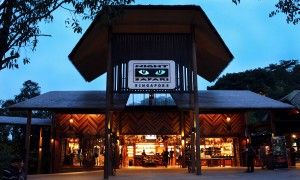
Ever imagine yourself walking amongst the jungle at night while stumbling upon lions, hyenas, and asian elephants, whom are highlighted under a moonlit sky – but without the threat of being eaten?
Thats what the Singapore night safari is like. The safari park is situated right next to the famous Singapore Zoo, it makes for a great stop after a day at the zoo, although you better have a ton of energy left over. I prefer one day for each. I’ll admit I was pretty hesitant at first when choosing the night safari as one of our adventures in the great Asian city…err country. I’m not big on zoos as I prefer to see them in the wild and I figured there wasn’t much to see in a “night” zoo since it would be dark.
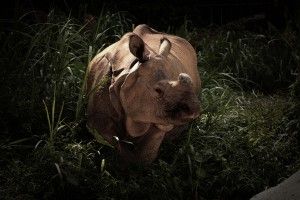
Boy was I wrong. We stumbled across golden cats, hippos, oryxes, barking deer, bantengs, gaurs, pelicans, tapirs, bharals, Himalayan tahrs, Marsh birds, mouse deer, babirusa, red river hogs, bongos, markhors, servals, rats, lions, tigers, and bears; OH MY!
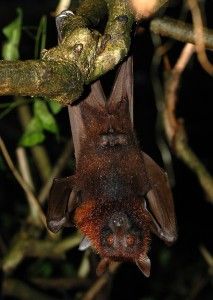
My personal favorites included the bat cage where we were free to roam in a free-flying bat house. We were able to see huge flying foxes within inches of our faces, and had the opportunity to look at them closely as they hung upside down, cloaked in their vampire capes. We also loved the giraffes, the hyenas, and the fishing cats, who kept us in anticipation without any climax. This is because the cats just stare at the water for what seems like hours and just when it looks like they are gonna pounce on an unsuspecting fish…they don’t. However, the fishing cat trail doesn’t just bring you to these amazing creatures but will also introduce you to the Binturongs, whose natural scent smells like popcorn.
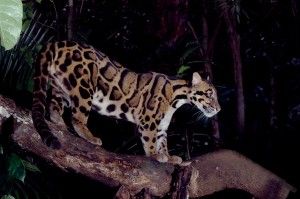
The Leopard trail on the other hand will bring you past Sri Lanken and clouded Leopards, malaysian civet cats, and even the Slow Loris; the only venomous primate in the world. You’ll also be rewarded with magical views of zebras and giraffes, whose hide tends to shine under the special lighting conditions.
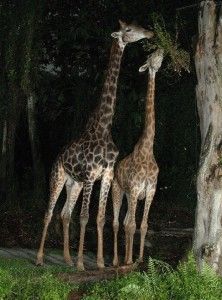
All the animals are displayed under a calming moonlit effect, which adds a perfect romantic atmosphere to the place. The walking trails were the best part, allowing you to occasionally feel secluded in the “jungle”, while bumping into majestic wildlife at every corner. The tram ride is also a great experience as it brings you around to see animals you can’t see on the walking trails, such as my all-time favourite – the white-tusked asian elephant who looked like a true king as he stood high under a starry sky. His white tusks glowed like something out of a fairytale. The greater asian rhinoceros was also amazing to see and I somewhat confused it for a dinosaur crossed with a robot.
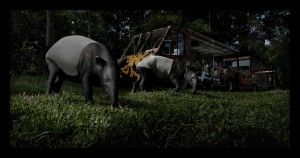
Some people told us that 2-3 hours were enough to explore the surroundings but for us, we could easily spend 5 hours without including the show, which is geared heavily towards young kids anyways. My suggestion (unless you’re with kids) is to skip the show and focus on walking the trails at a slow pace, taking in the peaceful ambience when you find yourself alone.
If you’re not one who will venture out into the wild jungles of Asia and Africa during the night to spot these amazing creatures, the night safari is practically your only chance to see these wonderful nocturnal animals up close, considering it’s the only night safari in the world.
Credits: All photos above are courtesy of Wildlife Reserves Singapore.
Reader Interactions
[…] The Singapore Night Safari is the world’s first nocturnal zoo and is one of the most popular tourist attractions in Singapore. The Night Safari currently houses over 2,500 animals representing over 130 species, of which 38% are threatened species. The Night Safari is managed by Wildlife Reserves Singapore and about 1.1 million visitors visit the safari per year. Embark into a fascinating journey to the world of the wildlife by getting into the tram safari experience. Other parts of the night safari are the following: Himalayan Foothills, Indian Subcontinent, Equatorial Africa, Indo-Malayan Region, Asian Riverine, Nepalese River Valley, Burmese Hillside & there are also walking trails that you may enjoy.©www.livelimitless.net©www.zoochat.com©nicholetyq.blogspot.com ©www.seawheel.com.sg […]
[…] Credit: livelimitless […]
[…] Source: Matthew G. Bailey […]
Leave a Reply Cancel reply
Your email address will not be published. Required fields are marked *
This site uses Akismet to reduce spam. Learn how your comment data is processed .
Travel Tips
- Limitless Travel
- Travel Hacking
Inspiration
- Limitless List
- The Podcast
- Your Complete Guide to Canada
- Canadian Travel Hacking
Chawang (Lasah) Asian elephant (Elephas maximus) at Singapore Night Safari in Singapore
Chawang (Lasah) is a living Male ♂ Asian elephant ( Elephas maximus) , located at the Singapore Night Safari , in Singapore .
Chawang (Lasah) arrived in 1991-10-07 to the Singapore Night Safari, relocated from the Singapore Zoo , in Singapore .
- ♀ Jamilah born 1976-00-00
- ♀ Neha born 2016-05-12
- ♂ Sang Wira born 2001
- ♀ Sri Nandong born 1985
- ♀ Tun born 1990
Total: 5 babies
- (M) 1999-03-24 Sang Raja EEP id: 9905
- (M) 2001 Sang Wira
- (M) 2010-11-23 -- † 2013 Nila Utama
- (F) 2016-05-12 Neha
Chawang (Lasah) is mentioned on Elephant News:
Sources used for this article is among others:.
- Langkawi Elephant Adventures
Relevant links
Internal relevant links.
- More elephants from: Singapore Night Safari
- More elephants from: Singapore
- All breeding cows
- All breeding bulls
- The elephant database startpage. Statistics
- List of all captive born elephants in the database
External relevant links (Opens in new window)
Chawang (lasah) mentioned on our sister website www.elephant-news.com, search more on the web for chawang (lasah).
(The name Chawang (Lasah) is already submitted into the link, just click on the link for relevant results)
- elephant-news.com
- Asianelephant.net
- Buckles Blog
- circushistory.org
- Elephant_Commentator
- Elefanten-Fotolexikon.eu
- elefanten.wikia
- Google Internet search
- Google Books
- ShowMe Elephants


IMAGES
COMMENTS
The first of my videos from my Singapore Trip. This is one of my favorite zoos, and some highlights included the Gaur (from tram ride), Kiwi, Hog Badger, and... Dr. Wolverine, 29 Mar 2024
Comments Information Mr Gharial A hotel stay will grant you 8AM access to the park, meaning you can visit the night safari early 10 Aug 2022 Vogelpark Avifauna Mr Gharial 10 Aug 2022 472 Forums Media > Europe > Netherlands > Vogelpark Avifauna >
Singapore Night Safari Singapore Night Safari species list Discussion in ' Singapore ' started by Chapman'szebra, 13 Dec 2020 .
Download a map of Night Safari in your preferred language and explore our park with ease!
1 likes, 0 comments - abdulsamad.457 on August 15, 2024: "Chiang Mai Night Safari. Date: 11 August, 2024. Pictures: Deers.".
For Night Safari, guests must select a time slot for a better experience. Upgrading works are taking place at Night Safari as we prepare to bring you more wildlife experiences. The park remains open during this period and we are extending local WildPass holders and tourists discounts* on Night Safari admission tickets. *T&Cs apply.
Discover the enchanting world of African night safaris and nocturnal wildlife, conservation efforts, and essential tips for planning your safari adventure.
Category: Singapore Night Safari Uploaded By: Zooish Date: 17 Apr 2010 View Count: 1,787 Comment Count: 1 ZooChat ForumsMedia>Asia>Singapore>Singapore Night Safari>
Here's what our beloved Night Safari looked like then vs now, from its iconic tram rides, trails, and thrilling animal performances.
After all, they're some of Singapore's staple attractions for both tourists and locals alike. The Singapore Zoo has won countless awards (including TripAdvisor's top 5 zoos in the world), and the Night Safari was the world's first-ever nocturnal zoo.
The Night Safari, Singapore is the world's first nocturnal zoo located in Mandai, Singapore. One of the most popular tourist attractions in the country, it forms a part of the Mandai Wildlife Reserve, consisting of the Singapore Zoo, Bird Paradise and River Wonders and the upcoming Rainforest Wild Park.
Keeper Talks Learn more about our wildlife from the people who know best — the keepers. In these interactive sessions, hear interesting quirks of the animals from our keepers.
Meet over 1,000 creatures from 120 species, as you embark on an adventure on our tram ride and walking trails at Night Safari.
Lions & Tigers & Bears, OH MY! - The Singapore Night Safari. Ever imagine yourself walking amongst the jungle at night while stumbling upon lions, hyenas, and asian elephants, whom are highlighted under a moonlit sky - but without the threat of being eaten? Thats what the Singapore night safari is like. The safari park is situated right ...
Chawang (Lasah) is a living Male ♂ Asian elephant ( Elephas maximus) , located at the Singapore Night Safari, in Singapore. Chawang (Lasah) arrived in 1991-10-07 to the Singapore Night Safari, relocated from the Singapore Zoo, in Singapore. Chawang (Lasah) lives together with 5 other elephants at the Singapore Night Safari:
Night Safari, the world's first nocturnal wildlife park and 12-time Best Attraction winner in Singapore.
Singapore Night Safari Singapore Night Safari species list Discussion in ' Singapore ' started by Chapman'szebra, 13 Dec 2020 .
However, the Singapore Night Safari always seems to get rave reviews from visitors so I thought I should see for myself. The park opens at 7.30pm and I got there at 8.30pm due to only having arrived in Singapore in the late afternoon.
@Thatzookeeperguy Nope, this was a one-off walkathon organized by a local newspaper. Otherwise, the Night Safari is open in the daytime on one day every February for a marathon. 28 Nov 2016
The origin of both is African Safari Wildlife Park. First one, Liouba (named after Alec's second wife from Russia) arrived in July 2002, at the age of 13 months.
Check out Night Safari ticket pricing, operating hours and important announcements before your visit. Book tickets online to enjoy more savings.
European golden jackal (Canis aureus moreotica) 0 320 7 0 30 Jan 2023 Page 1 of 52 1 2 3 4 5 6 → 52 Next > Forums Media > Europe > Russia >
Urgent translation of the info about current situation in zoo, acquired from staff. This is likely NOT to be highlighted in mass media. In 2013, just a year before the upcoming 150 th anniversary of Moscow Zoo, its director Vladimir Spitsin who worked here more than for 30 years, was moved to the post of 'Zoo President' (who actually has very few possibilities to govern the zoo).
ZooChat. Forums > Europe > Russia > Join our zoo community Sign up now! Moscow zoo Moscow zoo. Discussion in 'Russia' started by kiang, 26 Apr 2009.